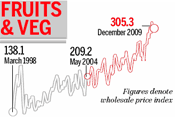THE FIGURES, GRAPHS TAKEN FROM INDIA TODAY WHICH CONDUCTED EXTENSIVE RESEARCH BASED ON MARKET DATA AND GOVT DATA.
Also, read my earlier posted article on Agricultural statistics at a glance. It is definitely one of those articles that receive maximum hits on my blog.
Also, read my earlier posted article on Agricultural statistics at a glance. It is definitely one of those articles that receive maximum hits on my blog.
hile China uses hybrid rice that allows it to produce 10,500 kg/hectare (ALMOST 5 Times as India's). Look at the price rise over 10 years
Our wheat production has increased but no proper storage mechanisms allow it to rot and the corrupt PDS won't let it reach the poor thereby spiralling prices.
Pulses required : 18 million tonnes Pulses Produced: 13 million tonnes
India is the LARGEST PRODUCER, IMPORTER AND CONSUMER of pulses. The middle east and other countries produce < 5 million tonnes. Hence, when we import global prices and local escalate.
We never have increased productivity and is the same output as in 1951.

GOVT Decides the price, sale and if sugar needs to be imported or exported. India is 2nd largest producer of sugar and when we import, global prices escalate. Best thing to do is decontrol sugar.

We could have been self-sufficient with edible oil, but due to poor oil seeds and low productivity, we are seeing the crisis.
Shortfall : 11 lakh tonnes to 43 lakh tonnes (from 1996-2008)
Our Consumption increase: 76 lakh tonnes to 120 lakh tonnes (from 1996 - 2008)
Output: 175 million tonnes and is 2nd largest producer in the world.
However, 70,000 Crore worth of produce is wasted because of storage issues and Govt not opening to retail reforms by which foreign companies can start processing the fruits/vegetables and ensure farmers get good price and there is no artificial scarcity. Retail outlets are much better than middlemen in many ways esp w.r.t prices.
When govt manipulates MSP (Minimum Support Price) prices of the essential items increase or decrease. this has to increase so that farmers get a fair share. Some figures:
RICE:
Rs.580/quintal to Rs. 1030/quintal => Price increased from Rs.13 to Rs.23/kg
WHEAT:
Rs.620/quintal to Rs.1100/quintal => Price increased from Rs.8 to Rs.14.5/kg
This subsidy bill - i.e giving lower price to Below and Above poverty Lines costs the Govt Rs.90,000 Crore every year
Govt should really do contract farming, allowing companies to lease the land, ask farmers to grow and give them a fair price based on rates in the market. Pretty much like Public private participation that has boomed highways sector.
| THE BITE VIEW Board of India Today Economists gives its views on how to bite the bullet on runaway inflation | ||||||||
| WHY PRICES ARE RISING? | ||||||||
 |  |  | ||||||
|
|
| ||||||
 |  | |||||||
|
| |||||||
| HOW TO REIN IN THE RISE? | |||||
|
|
| |||
|
| ||||





No comments:
Post a Comment